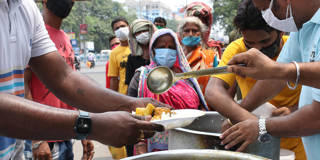Ensuring that poverty-alleviation initiatives reach those most in need has been slow and difficult in most developing countries. But if governments make the most of existing data and systems, carry out multidimensional local assessments, and commit to continuous improvement of targeting methods, progress is possible.
NEW YORK – We are at the halfway point for implementing the Sustainable Development Goals (from 2015 to 2030), but we are not halfway to achieving them. In fact, in many critical areas – from poverty to food security – progress has been reversed in recent years, owing to severe and compounding crises. In this difficult environment, governments worldwide must urgently recommit to the SDGs, including their underlying promise to leave no one behind.
The challenge is formidable. Consider SDG1, which aims to eliminate poverty in all its forms. According to the World Bank’s Partnership for Economic Inclusion, government-led poverty-alleviation programs surged in 2021. But to reach those furthest behind, such programs must recognize and account for the web of overlapping constraints that effectively “trap” people in poverty.
As the global Multidimensional Poverty Index highlights, poverty encompasses deprivation and exclusion in multiple areas, such as nutrition, sanitation, health care, and education. Factors like gender, disability, and displacement also play an important role in keeping people in poverty. Recent research, based on experience in rural Bangladesh, shows that below a certain income/asset threshold, households’ ability to access resources that could increase their income is severely limited. It also shows that large transfers of resources and/or support that create better jobs for the poor are an effective means of enabling people to escape the poverty trap over the long term.

NEW YORK – We are at the halfway point for implementing the Sustainable Development Goals (from 2015 to 2030), but we are not halfway to achieving them. In fact, in many critical areas – from poverty to food security – progress has been reversed in recent years, owing to severe and compounding crises. In this difficult environment, governments worldwide must urgently recommit to the SDGs, including their underlying promise to leave no one behind.
The challenge is formidable. Consider SDG1, which aims to eliminate poverty in all its forms. According to the World Bank’s Partnership for Economic Inclusion, government-led poverty-alleviation programs surged in 2021. But to reach those furthest behind, such programs must recognize and account for the web of overlapping constraints that effectively “trap” people in poverty.
As the global Multidimensional Poverty Index highlights, poverty encompasses deprivation and exclusion in multiple areas, such as nutrition, sanitation, health care, and education. Factors like gender, disability, and displacement also play an important role in keeping people in poverty. Recent research, based on experience in rural Bangladesh, shows that below a certain income/asset threshold, households’ ability to access resources that could increase their income is severely limited. It also shows that large transfers of resources and/or support that create better jobs for the poor are an effective means of enabling people to escape the poverty trap over the long term.